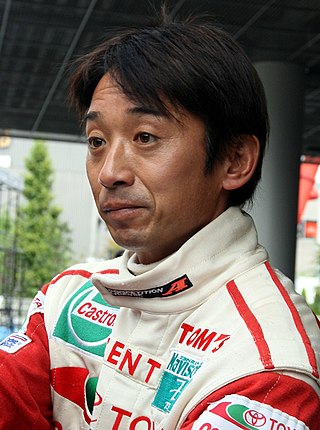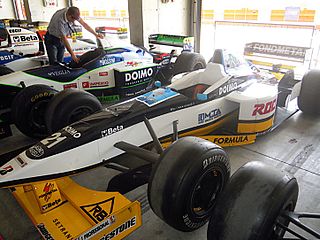
British American Racing (BAR) was a Formula One constructor that competed in the sport from 1999 to 2005. BAR began by acquiring Tyrrell, and used Supertec engines for their first year. Subsequently, they formed a partnership with Honda which lasted for the next six years.
Yamaha Motor Co., Ltd. is a Japanese mobility manufacturer that produces motorcycles, motorboats, outboard motors, and other motorized products. The company was established in the year 1955 upon separation from Nippon Gakki Co., Ltd. and is headquartered in Iwata, Shizuoka, Japan. The company conducts development, production and marketing operations through 109 consolidated subsidiaries as of 2012.
The Tyrrell Racing Organisation was an auto racing team and Formula One constructor founded by Ken Tyrrell (1924–2001) which started racing in 1958 and started building its own cars in 1970. The team experienced its greatest success in the early 1970s, when it won three Drivers' Championships and one Constructors' Championship with Jackie Stewart. The team never reached such heights again, although it continued to win races through the 1970s and into the early 1980s, taking the final win for the Ford Cosworth DFV engine at the 1983 Detroit Grand Prix. The team was bought by British American Tobacco in 1997 and completed its final season as Tyrrell in the 1998 Formula One season. Tyrrell's legacy continues in Formula One as the Mercedes-AMG F1 team, who is Tyrrell's descendant through various sales and rebrandings via BAR, Honda, and Brawn GP.

Ukyo Katayama is a Japanese former racing driver and motorsport executive, who competed in Formula One from 1992 to 1997.

Michele Alboreto was an Italian racing driver, who competed in Formula One from 1981 to 1994. Alboreto was runner-up in the Formula One World Drivers' Championship in 1985 with Ferrari, and won five Grands Prix across 14 seasons. In endurance racing, Alboreto won the 24 Hours of Le Mans in 1997 with Joest, as well as the 12 Hours of Sebring in 2001 with Audi.

The 1994 Japanese Grand Prix was a Formula One motor race held on 6 November 1994 at the Suzuka Circuit, Suzuka. It was the fifteenth and penultimate race of the 1994 Formula One World Championship. In wet conditions, the 50-lap race was won by Damon Hill, driving a Williams-Renault, after he started from second position. Hill's Drivers' Championship rival Michael Schumacher finished second in his Benetton-Ford, having started from pole position, with Jean Alesi third in his Ferrari. The win left Hill just one point behind Schumacher in the Drivers' Championship with one race remaining. This also proved to be the last Grand Prix for Érik Comas. This was also the last time in Formula 1 history when the race was split in two parts due to race stoppage and final classification has been set by aggregate time.

The 1998 FIA Formula One World Championship was the 52nd season of FIA Formula One motor racing. It featured the 1998 Formula One World Championship for Drivers and the 1998 Formula One World Championship for Constructors, which were contested concurrently over a sixteen-race series that commenced on 8 March and ended on 1 November.

The 1997 FIA Formula One World Championship was the 51st season of FIA Formula One motor racing. It featured the 1997 Formula One World Championship for Drivers and the 1997 Formula One World Championship for Constructors, which were contested concurrently over a seventeen-race series that commenced on 9 March and ended on 26 October.

The 1996 FIA Formula One World Championship was the 50th season of FIA Formula One motor racing. The championship commenced on 10 March and ended on 13 October after sixteen races. Two World Championship titles were awarded, one for Drivers and one for Constructors.

The 1995 FIA Formula One World Championship was the 49th season of FIA Formula One motor racing. It featured the 1995 Formula One World Championship for Drivers and the 1995 Formula One World Championship for Constructors, which were contested concurrently over a seventeen-race series that commenced on 26 March and ended on 12 November.

Judd is a brand of racing car engines built by Engine Developments Ltd., a company founded in 1971 by John Judd and Jack Brabham in Rugby, Warwickshire, England. Engine Developments was intended to build engines for Brabham's racing efforts, and became one of the first firms authorised by Cosworth to maintain and rebuild its DFV engines, but has since expanded into various areas of motorsport.

The BAR 01 was the car with which the British American Racing Formula One team competed in the 1999 Formula One season, its inaugural year in the series after purchasing Tyrrell. It was driven by Jacques Villeneuve, the 1997 Champion who had left Williams in order to work with team principal Craig Pollock, his manager and good friend. The second driver was Ricardo Zonta, the 1997 Formula 3000 champion and 1998 FIA GT champion, although Mika Salo would deputise early in the season after the Brazilian injured his ankle at Interlagos.

The Arrows A19 was the car with which the Arrows Formula One team competed in the 1998 Formula One World Championship. It was driven by Brazilian Pedro Diniz, who was in his second season with the team, and Finn Mika Salo, who had moved from Tyrrell to replace Jordan-bound Damon Hill.

The Tyrrell 025 was the car with which the Tyrrell team competed in the 1997 Formula One World Championship. It was driven by Finn Mika Salo, who was in his third season with the team, and Dutchman Jos Verstappen, who moved from Footwork.

The Minardi M197 was the car with which the Minardi Formula One team competed in the 1997 Formula One season.

The Tyrrell 023 was a Formula One car designed by Harvey Postlethwaite and Mike Gascoyne for use by the Tyrrell team in the 1995 Formula One World Championship. The car was driven by Japanese Ukyo Katayama, in his third season with the team, and Finn Mika Salo, in his first full season of F1 after driving for Lotus in the final two races of 1994. The team's test driver, Italian Gabriele Tarquini, deputised for an injured Katayama at the European Grand Prix. The best finish achieved by the 023 was fifth, by Salo at the Italian and Australian Grands Prix.

The Tyrrell 022 was the car with which the Tyrrell team competed in the 1994 Formula One World Championship. The car was powered by the Yamaha OX10B 3.5-litre V10 engine and was driven by Japanese Ukyo Katayama, in his second season with the team, and Briton Mark Blundell, who moved from Ligier.

Footwork Arrows was a British Formula One motor racing team which competed from 1991 to 1996. Japanese businessman Wataru Ohashi, who was the president of Footwork Express Co., Ltd., a Japanese logistics company, began investing heavily in the Arrows team in 1990, the deal including requiring the cars to display the Footwork logo prominently. The team was officially renamed Footwork in 1991, and secured a deal to race with Porsche engines. Results were poorer than expected, and after just six races, Footwork dropped the Porsche engines and continued with Hart-built Ford engines.

The Tyrrell 020 was a Formula One racing car designed by Harvey Postlethwaite and George Ryton for Tyrrell Racing and raced during the 1991 season, the entire 1992 season and the half of 1993 season.
The EC and ED family are a series of 3.0-litre and 3.5-litre, naturally-aspirated, V8, Formula One racing engines, designed, developed and produced by Cosworth, with funding from and in partnership with Ford; and used between 1994 and 1997. The customer engines were used by Benetton, Sauber, Forti, Lola, Simtek, Pacific, Minardi, and Tyrrell.


















